The Invisible Living World: Beyond Our Naked Eye Chapter Notes | Science Curiosity Class 8 - New NCERT PDF Download
Introduction
Have you ever wondered about the incredibly tiny living things that fill our world, but remain hidden from our sight?
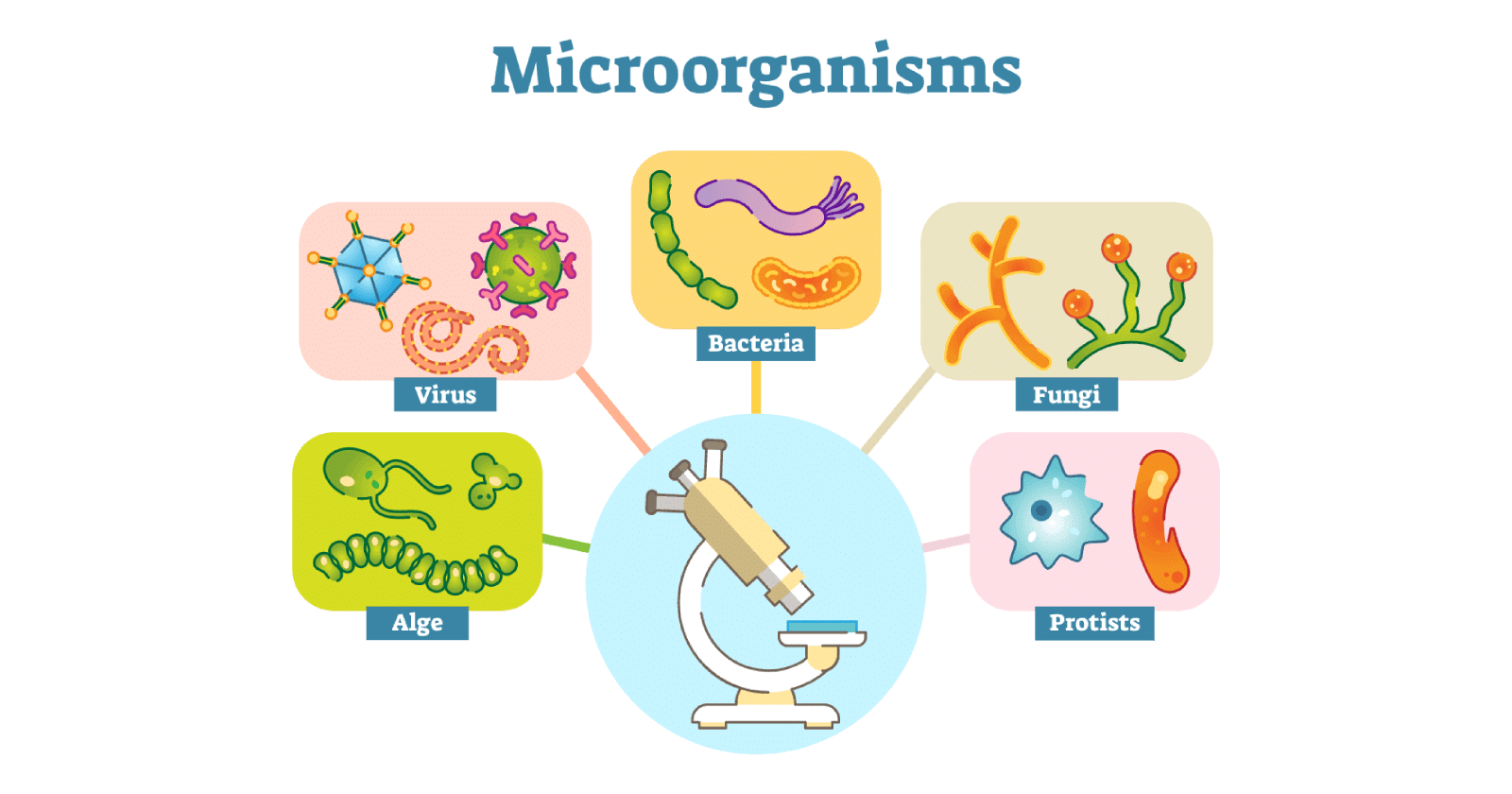
- This chapter takes you on a journey into the "invisible living world"—the microscopic universe full of life, and reveals how scientific tools such as lenses and microscopes have helped us discover, understand, and utilize these unseen organisms.
- You’ll also learn about the basic unit of life—the cell, and how microorganisms are deeply interconnected with our lives.
The Limits of Human Vision and Discovery of Lenses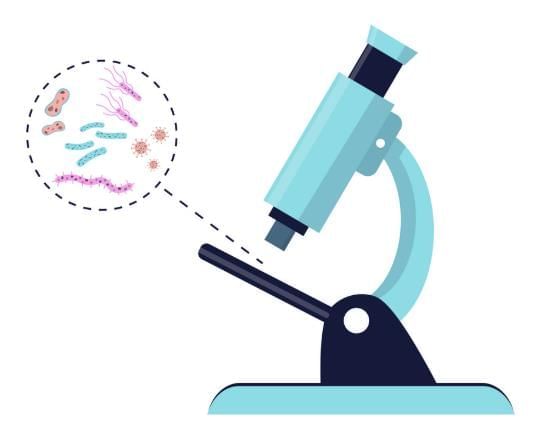 Microscope allows us to observe things that are too small
Microscope allows us to observe things that are too small
- Our eyes can only see objects above a certain size. Many tiny things around us are invisible to the naked eye.
- Long ago, people did not know about the many small organisms living around (and even on) us!
- People learned that a curved piece of glass can make small things look bigger.
- This piece of glass is called a lens (because it’s thick in the middle like a lentil seed).
- Over time, better lenses led to the creation of magnifying glasses and, later, microscopes.
- Magnifying glasses and microscopes allow us to observe things that are too small for the naked eye.
How a Magnifying Glass Works
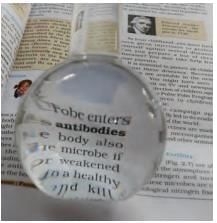 Round Bottom Flask
Round Bottom Flask
- If you fill a round-bottom flask with water and seal it, you can use it as a simple magnifying glass.
- When you look through this flask at a book, the letters appear bigger.
- This is because the flask acts like a lens, bending light and making objects look larger.
- Using a real magnifying glass, you can see the details of tiny organisms (like ants) more clearly.
- Such tools help us explore the tiny living world that is otherwise hidden.
The Invention of the Microscope
People were always curious about small things but couldn’t see them until the invention of the microscope. A microscope makes tiny things appear much bigger and reveals details not seen by the naked eye.
Robert Hooke (1665):Robert Hooke and his Microscope
- Published the book Micrographia, with detailed drawings of tiny living things as seen under a microscope.
- Used a microscope that made objects appear 200–300 times bigger.
- Observed thin slices of cork and saw small, empty compartments.
- Called these compartments cells (the first use of the word in science).
- Realized that all living things are made up of such basic units.
Antonie van Leeuwenhoek (1660s): Antonie van Leeuwenhoek
Antonie van Leeuwenhoek
- Improved the lenses and built better microscopes.
- First to clearly observe and describe living cells like bacteria and blood cells.
- Known as the Father of Microbiology for his discoveries of the invisible living world.
What Is a Cell?
Cells are the basic building blocks of all living beings—plants, animals, and even humans. Cells cannot always be seen with the naked eye. We observe them using a microscope.
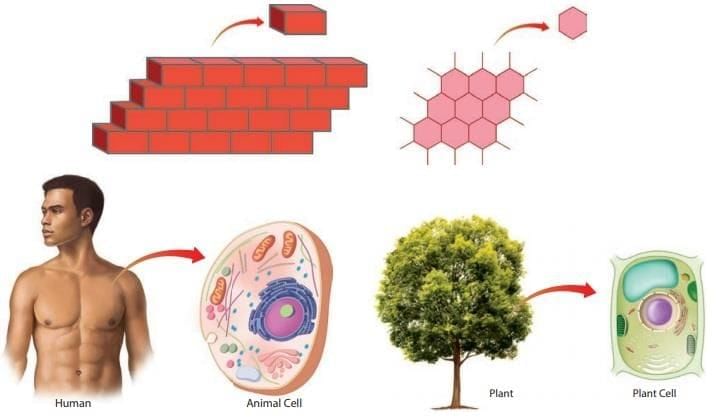 Basic Building Blocks: Cells
Basic Building Blocks: Cells
Observing Plant and Animal Cells
1. Studying Onion Peel Cells (Plant Cell)
An onion bulb has a thin, transparent layer called the onion peel. Staining (with red safranin) helps make cells visible. Under the microscope, onion peel cells appear rectangular and are packed closely together.
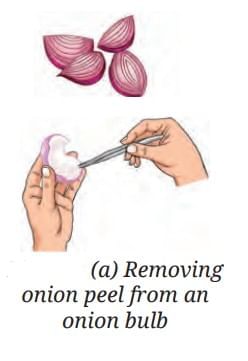
These cells have:
- A cell wall (extra outer layer). Cell wall gives strength and rigidity to plant cells.
- Cell membrane (inside the cell wall, outer lining of cell)
- Cytoplasm (jelly-like substance filling the cell)
- Nucleus (round structure in the center)
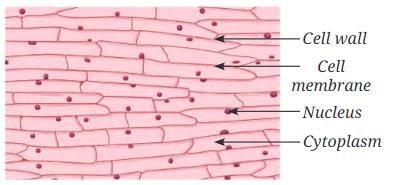 Onion Peel Cell
Onion Peel Cell
2. Studying Cheek Cells (Animal Cell)
Scraping the inside of your cheek gives cheek cells. These are stained with methylene blue to make them easier to see. Cheek cells are polygon-shaped (irregular), flat, and have:
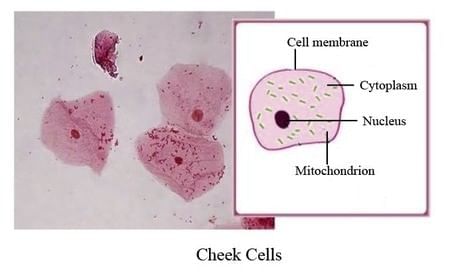
- Cell membrane (outer boundary)
- Cytoplasm
- Nucleus
- Animal cells do NOT have a cell wall.
Main Parts and Structure of a Cell
All cells have three basic parts:
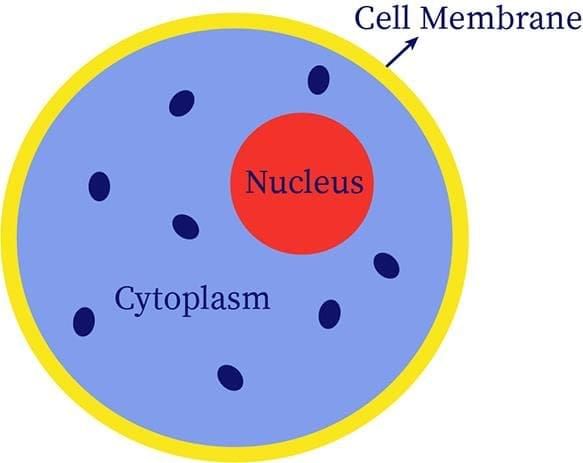
1. Cell Membrane:
- Thin, flexible layer forming the boundary of the cell.
- Separates one cell from another.
- Porous, allowing certain materials to enter or exit; keeps harmful substances out and retains useful molecules.
2. Cytoplasm:
- Jelly-like substance filling most of the cell inside the membrane.
- Contains dissolved nutrients like carbohydrates, proteins, fats, and mineral salts.
- Most cellular life processes occur here.
3. Nucleus:
- Spherical or oval structure, usually located centrally.
- Controls all cell activities, including growth and division.
- Surrounded by its own thin membrane.
Plant cells have extra parts:
1. Cell Wall (in plants only):
- A tough, outer layer surrounding the cell membrane.
- Provides rigidity, strength, and protection to plant cells.
- Makes cells appear firm and compactly arranged.
2. Plastids (including chloroplasts, in plants only):
- Tiny rod-shaped structures within plant cells.
- Chloroplasts contain chlorophyll and enable photosynthesis.
- Other plastids help store food and substances.
3. Vacuole:
- Large, clear cavity in plant cells; smaller or absent in animal cells.
- Stores nutrients, waste, and helps maintain cell shape and turgidity.
Differences Between Plant and Animal Cells
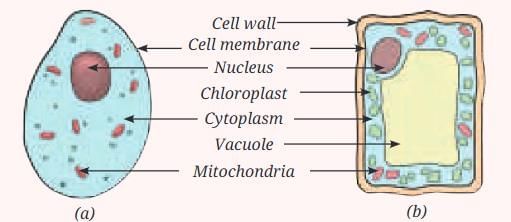 (a) An animal cell and (b) A plant cell
(a) An animal cell and (b) A plant cell
| Feature | Plant Cell | Animal Cell |
|---|---|---|
| Cell wall | Present | Absent |
| Nucleus | Present, usually at one side | Present, often central |
| Vacuole | Large, central | Small or absent |
| Plastids | Present (e.g., chloroplasts) | Absent |
| Shape | Rectangular, rigid | Irregular, flexible |
Variation in Shape and Structure of Cells
Cells within living organisms can have different shapes, sizes, and structures, depending on their role and location.
- Muscle cells: Spindle-shaped (tapered ends), designed for contracting and relaxing to enable movement.
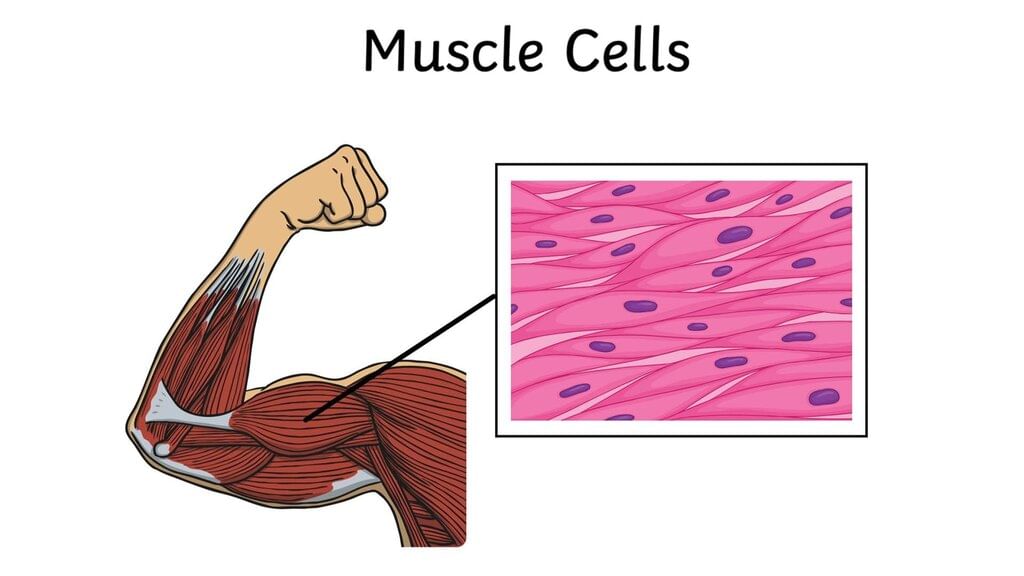
- Nerve cells (neurons): Long and branched, suitable for carrying messages quickly across the body.
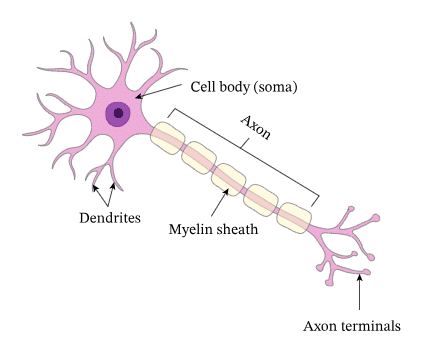 Nerve Cell
Nerve Cell - Cheek cells: Thin and flat, forming a protective lining.
- Plant cells/ Onion Cells: May be rectangular, elongated, oval, or tube-shaped; some form long tubes for transporting water.
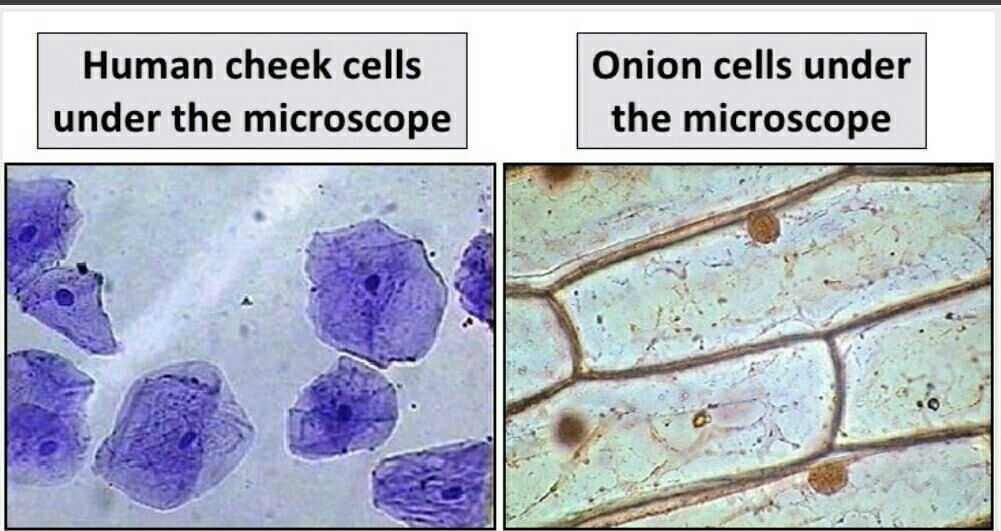
Why Do Cells Differ in Shape and Structure?
The unique shape and size of each cell type help it perform specific functions for the organism.
- Nerve cells must reach distant parts, so they are long and extended.
- Muscle cells contract and relax, so their spindle shape helps this motion.
- Plant tube cells transport water, so they are elongated and tube-like.
Role of Different Cells in Body Functions
- In humans, muscle cells in the digestive tract move food by contracting in waves.
- The stomach contains muscle cells for churning food and specialized cells for producing digestive juices and acids.
- In plants, tube-like cells help move water and nutrients up the stem and into leaves.
What Are the Levels of Organisation in the Body of a Living Organism?
The structure of every living organism—from tiny plants to complex animals—is organized in a systematic and hierarchical way. This organisation allows the body to function efficiently, as each level is built from the previous, simpler level.
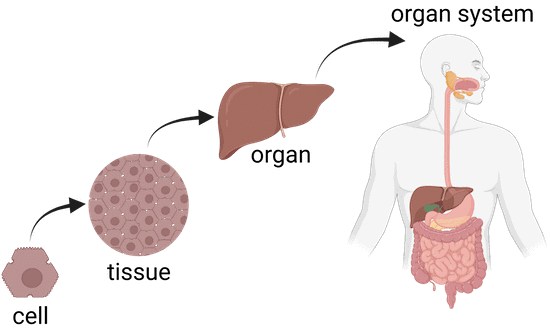 Level of Organisation
Level of Organisation
1. Cell – The Basic Unit of Life
The cell is the smallest, most fundamental unit of all living beings.
- Just as a brick is the basic building block of a wall, a cell is the building block of life.
- Each cell performs all the basic processes necessary for life, such as taking in nutrients, producing energy, and reproducing.
2. Tissue – Group of Similar Cells
- A tissue is a group of similar cells that work together to perform a specific function.
- Muscle tissue (made of muscle cells for movement), nerve tissue (made of nerve cells for message transmission), etc.
- Tissues provide structure and support to organs and help in carrying out specialized tasks.
3. Organ – Structure Formed by Different Tissues
- An organ is formed when different types of tissues combine and work together to perform a particular function.
- Heart (pumps blood), stomach (helps in digestion), leaf (photosynthesis in plants).
- Each organ has a specific structure and role in the body.
4. Organ System – Group of Organs for Major Functions
- An organ system is a group of organs that work together to perform a major life function.
- Digestive system (mouth, stomach, intestines, etc.), respiratory system (lungs, windpipe), circulatory system (heart, blood vessels).
- Each organ system takes care of major tasks, ensuring the survival and wellbeing of the organism.
5. Organism – Complete Living Being
- All the organ systems together make up a complete, multicellular organism—like a plant, animal, or human.
- The organism is able to perform all the functions of life: growth, development, response to the environment, and reproduction.
Summary Table: Levels of Organisation
| Level | Description / Definition | Example |
|---|---|---|
| Cell | Basic unit of life | Muscle cell, nerve cell |
| Tissue | Group of similar cells | Muscle tissue, nervous tissue |
| Organ | Structure formed by different tissues | Heart, stomach, leaf |
| Organ system | Group of organs working for a major function | Digestive system, circulatory system |
| Organism | All organ systems combined as a living being | Plant, human, animal (dog, bird, etc.) |
What Are Microorganisms?
Some living organisms are so incredibly small that they are invisible to the naked eye. Unlike the plants, animals, and cells we've seen before, these tiny forms of life require special tools just to be observed.
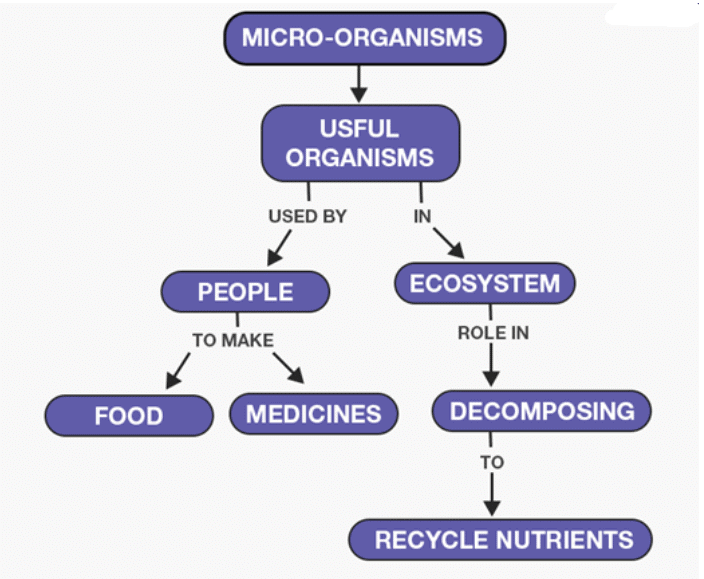
Microorganisms (or microbes):
- Living beings made up of just one cell (unicellular) or only a few cells.
- They are so tiny that we cannot see them without the aid of a microscope.
- The word "microorganism" comes from "micro" (very small) and "organism" (living being).
Key Points About Microorganisms
- Size: Too small to see without a microscope; invisible to unaided eyes.
- Cellularity: Some (like bacteria and Amoeba) are unicellular (single-celled). Others (like some fungi and algae) can be multicellular (made of many cells) but still remain extremely small.
- Everywhere: in water, soil, air, on and inside our bodies, and in extreme places too.
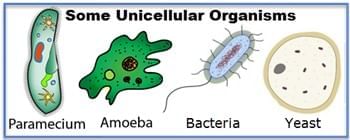
How Do We See Microorganisms?
Microscopes are needed to observe the cells of microorganisms. Microscopes enlarge (magnify) the image of microbes so they become visible.
Types of Microscopes:
- Laboratory Microscopes: High-powered, show clear details but are expensive.
- Foldscope: A low-cost, foldable paper microscope that allows more people to study microbes, though it may not show as much detail as advanced microscopes.
Are Microorganisms the Same as Plant or Animal Cells?
- Like plant and animal cells, microbial cells may have a cell membrane, cytoplasm, and sometimes a nucleus.
- However, there are many differences in size, structure, and the way they perform life processes.
- Not all microbes have the same features as plant or animal cells; some can be quite unique.
Where Do We Find Microorganisms?
- In Water: Lakes, rivers, oceans, ponds, even in a drop of water!
- In Soil: The earth is full of bacteria, fungi, and protozoa.
- In Air: Some float in the atmosphere.
- Inside Living Beings: Many live in our intestines or on our skin—helping or sometimes causing illness.
Why Are Microorganisms Important?
Microbes play crucial roles in nature—including recycling nutrients, decomposing waste, supporting plant growth, and even digesting food in our bodies!
How Are We Connected to Microbes?
- Microorganisms (microbes) are found all around us—not just in laboratories or textbooks, but in every corner of our daily lives.
- You may have noticed when fruits like lemons, tomatoes, or oranges are left out, they sometimes develop a powdery or cotton-like growth.
- This is microbial growth (usually fungi); the food has been infected by microbes.
- These microbes reach food from the air, water, soil, or even by landing on the food surface.
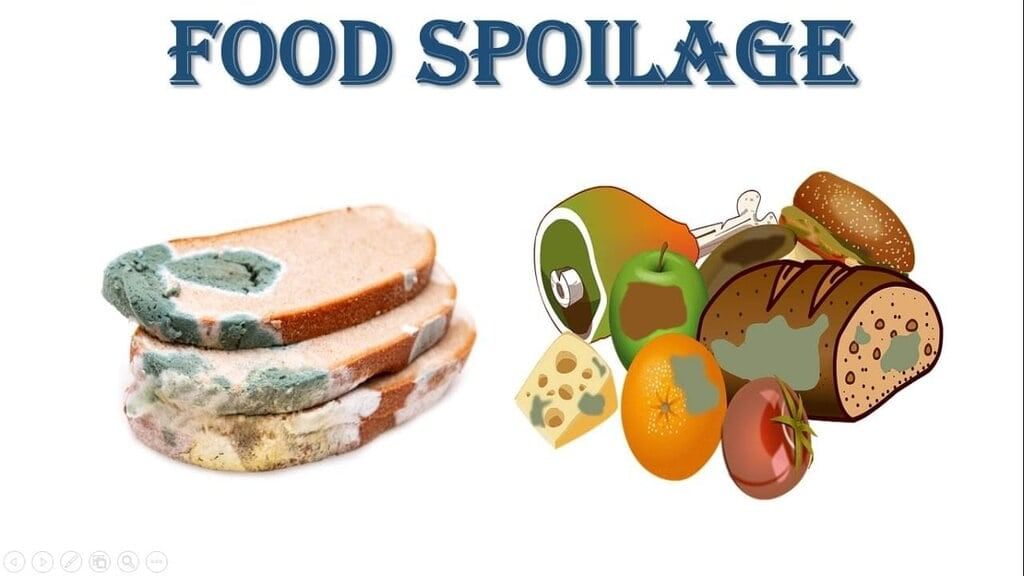
Where Can Microorganisms Be Found?
- On food: Responsible for spoilage and rotting (mouldy bread, spoiled fruits).
- On plant surfaces: Leaves, stems, and roots all have microbial residents.
- In water, soil, and air: Microbes thrive in ponds, rivers, soil, and even float in the air.
- Inside living beings: The human body (especially the intestine) is home to many bacteria that help with vital functions like digestion.
- Extreme environments: Some microbes live in very hot springs, icy cold zones, or salty lakes—showing their incredible adaptability and diversity.
Microbial Diversity
- Microbes come in many shapes: spherical, rod-shaped, spiral, and irregular.
- Like animals and plants, they also vary in size, structure, and function.
- This diversity allows them to survive everywhere and play different roles.
Key Players in Cleaning the Environment
Microbes, especially bacteria and fungi, break down dead plant and animal matter, turning it into simpler substances (decomposition).
- This process is what turns fallen leaves and fruit peels into manure (compost), enriching the soil for healthy plant growth.
- Ancient texts (the Vedas) recognized both visible and invisible "tiny entities" (Krimi), mentioning their helpful and harmful effects—showing the long-standing appreciation of microbes.
Manure Formation
- When organic waste (like fruit and vegetable peels) is left in moist soil for a few weeks, microbes decompose it, forming dark-coloured, nutrient-rich manure.
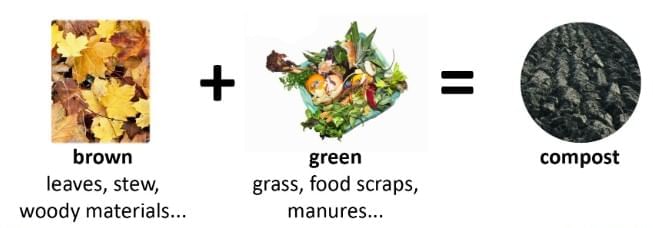
- This process needs optimal temperature and moisture.
- The nutrients released go back into the soil, supporting new plant growth.
- Microbes also decompose animal waste (like dung), cleaning up the environment naturally.
- They even break down dead animal bodies, ensuring nature recycles its resources.
- Without microbes, waste and dead matter would accumulate and the recycling of nutrients would stop.
Why Don’t Microbes Spoil Pickles and Murabbas?
- Preservation with Salt and Sugar: Pickles and murabbas are made with high concentrations of salt or sugar.
- These act as preservatives and prevent the growth of microbes, so the food does not spoil easily.
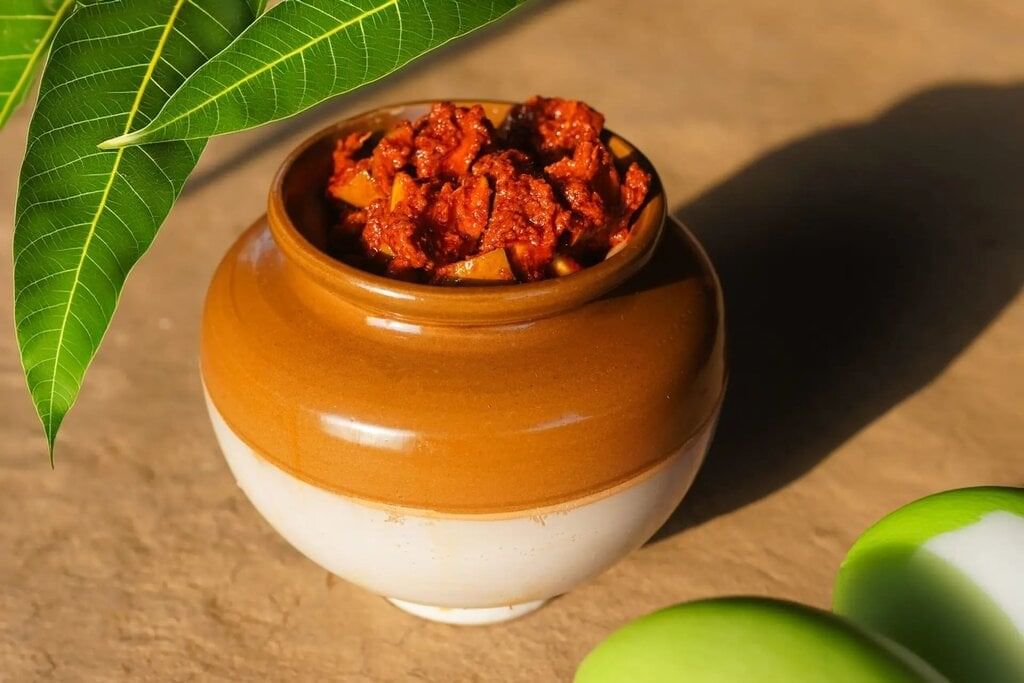 Mango Pickle
Mango Pickle
Microbes as a Source of Biogas
- Some bacteria and fungi can grow in places where there is no oxygen (anaerobic conditions).
- These microbes decompose plant and animal waste, releasing gases—mainly methane and carbon dioxide.
- Methane (biogas) is an important renewable fuel used for cooking, heating, electricity, and even running vehicles.
- Real-Life Example: Dr. Ananda Mohan Chakrabarty developed a special bacterium that can break down oil spills (patented in 1980), showing how microbes can help solve real-world pollution problems.
Microorganisms in Food Preparation
Fermentation and Rising of Dough
- Yeast (a fungus) is used to make dough rise for breads, cakes, and some Indian foods:
- When mixed with flour and warm water, yeast ferments sugars, releasing carbon dioxide (which forms bubbles, making the dough soft and fluffy) and a little alcohol (which adds to the smell).
- Bowl experiment: Dough with yeast becomes fluffy and airy; without yeast, it stays dense.
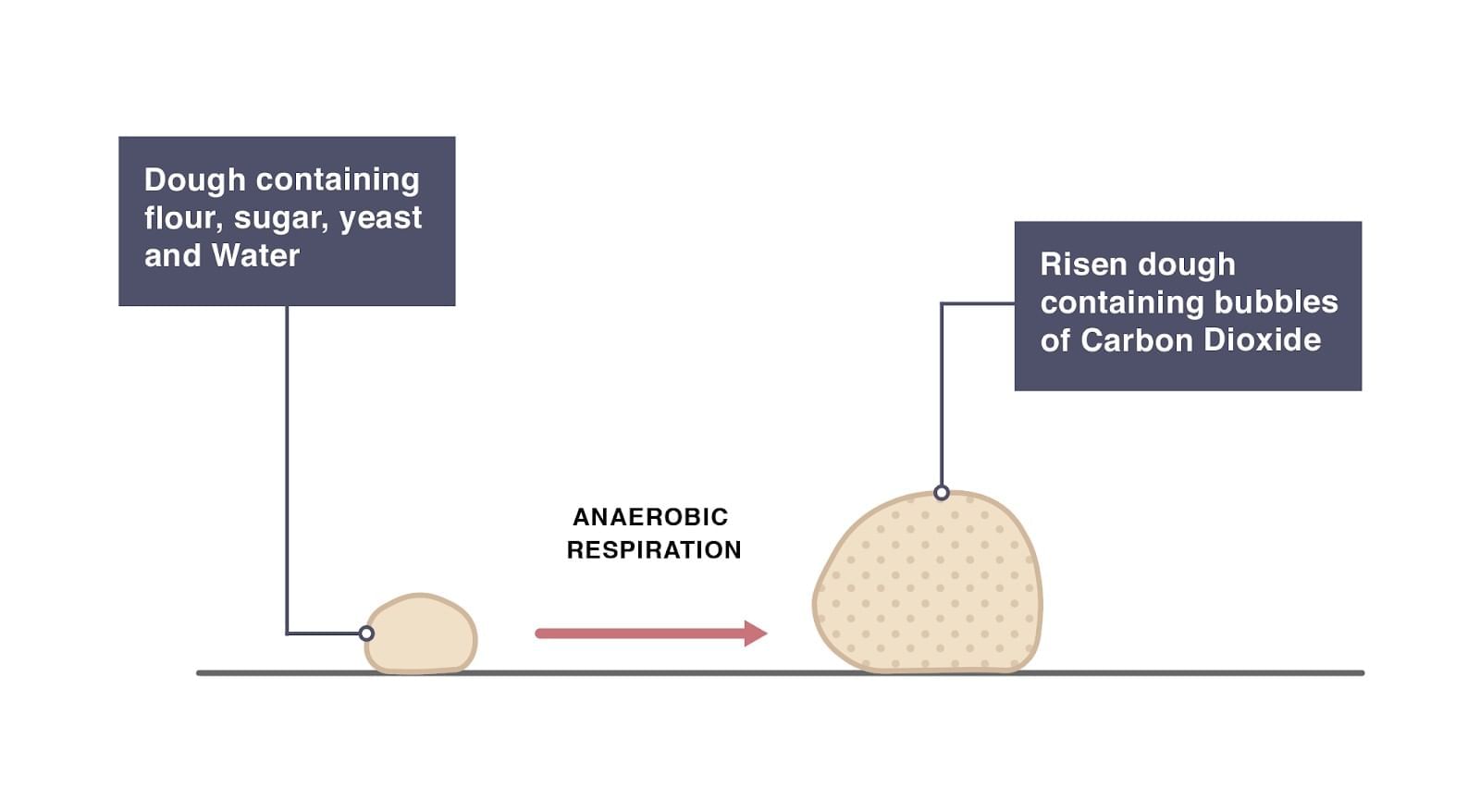
Formation of Curd and Other Fermented Foods
- Lactobacillus (a type of bacteria) is used in curd formation:
- Added to warm milk, it multiplies and converts sugars (lactose) into lactic acid, making the milk sour and thick (curd).
- This needs a warm environment to work well.
- Warm milk forms curd quickly; cold milk does not.
- Bacteria like Lactobacillus and yeast help in fermentation for foods like idli, dosa, and bhatura.
- All these organisms make our food tastier, more nutritious, and sometimes easier to digest.
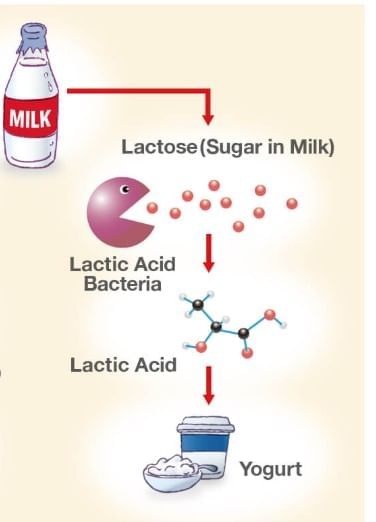
Nitrogen Fixation
- Rhizobium bacteria live in the root nodules of legumes (peas, beans).
- These bacteria convert nitrogen from the air into forms plants can use, improving soil fertility naturally (without chemical fertilizers).
- This is why farmers grow legumes in crop rotation.
Amazing Microalgae: Tiny Helpers in Water
Microalgae are microscopic, plant-like organisms found in water, soil, air, and even on tree bark.
- They perform photosynthesis (making food from sunlight) and release oxygen—more than half of the Earth’s oxygen comes from microbes like these.
- They are a major food source for aquatic animals.
- Some, like Spirulina, Chlorella, and Diatoms, are used as dietary supplements and medicines for humans.
Other Benefits
- Microalgae help in cleaning water and are being developed as a source of biofuel (clean energy).
- However, they are threatened by pollution, climate change, and loss of habitat.
- Conserving microalgae is important for maintaining oxygen supply, food security, and the health of aquatic ecosystems.
Example: Spirulina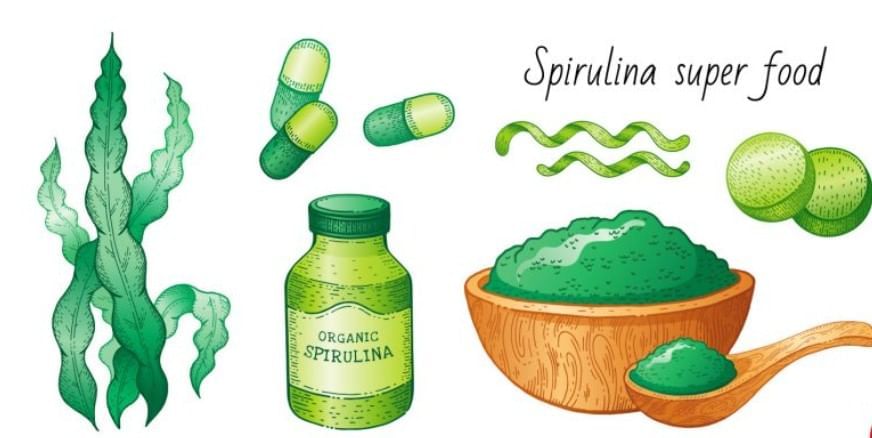
- Known as a "superfood" because it is rich in protein (over 60%) and vitamin B12, while being low in fat and sugar.
- Spirulina can be easily farmed in tanks with pond water, moderate temperature, and sunlight.
- Spirulina farming is a growing livelihood option for communities.
Why Is the Cell Considered the Basic Unit of Life?
The cellis called the basic unit of life because it is the smallest structure that can carry out all the functions necessary for survival. All living organisms—plants, animals, and microorganisms—are made up of cells.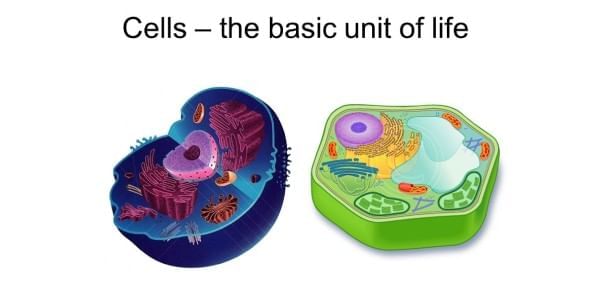
Multicellular organisms (plants and animals):
- The bodies of all plants and animals are made up of many cells so, they are called Multicellular organisms.
- These cells are specialized to perform different functions (e.g., skin cells, muscle cells, nerve cells).
- Cells cooperate and communicate with each other to keep the whole organism alive.
- Each type of cell plays a unique role, but all are essential for survival.
- Examples of multicellular organisms are: Plants, animals, humans.
Unicellular organisms (bacteria, protozoa, some fungi and algae):
- They are made up of only one single cell.
- This single cell performs all life processes—nutrition, movement, reproduction, growth, and response to the environment.
- Examples of unicellular organisms are: Bacteria, amoeba, yeast.
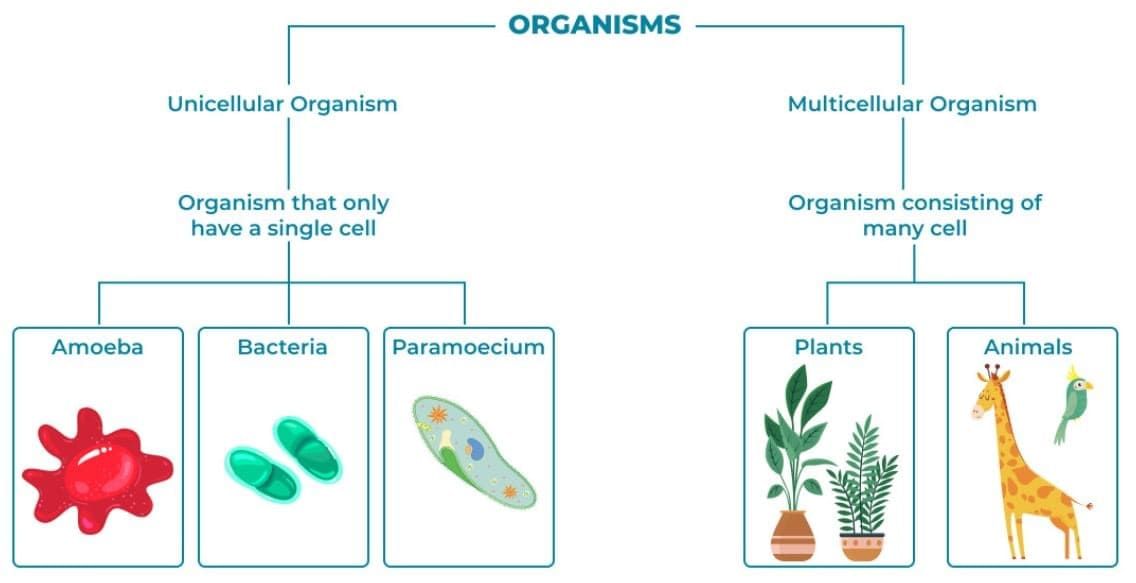
Examples of Microbial Organization
- Bacteria and protozoa are usually unicellular (single-celled).
- Some algae and fungi can be unicellular or multicellular:
- Yeast: A unicellular fungus (lives as single cells).
- Moulds: Multicellular fungi (made of many cells).
Components and Structure of Cells
- All cells are typically surrounded by a cell membrane (keeps contents in and controls movement of substances).
- Fungal cells have an extra cell wall (for protection and shape), but unlike plant cells, they don’t have chloroplasts and cannot make their own food.
- Bacterial cells are different: They do not have a well-defined nucleus or a nuclear membrane. Instead, their genetic material is found in a region called the nucleoid.
- In plant and animal cells, the nucleus is clearly defined and surrounded by a membrane.
Special Features in Cells
- There are many parts inside cells (called organelles), each with a special function.
- To see even smaller details, you need stronger microscopes:
- Electron microscopes can magnify cells up to 10,00,000 times (revealing structures not seen with ordinary microscopes).
Diversity in Cells
- Cells vary in size, shape, and structure based on their function and the organism they belong to.
- Even plant and animal cells are different in how they look and what structures they contain.
|
54 videos|256 docs|13 tests
|
FAQs on The Invisible Living World: Beyond Our Naked Eye Chapter Notes - Science Curiosity Class 8 - New NCERT
| 1. What is the basic definition of a cell? |  |
| 2. What are the different levels of organization in the body? |  |
| 3. What are microorganisms and why are they important? |  |
| 4. How are humans connected to microbes? |  |
| 5. Why is the cell considered the basic unit of life? |  |






















